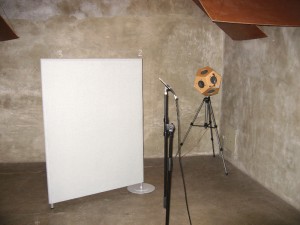Measurement of the airflow resistivity, porosity etc.
- determination of the airflow resistivity with airflow resistivity meter AcoustiFlow® on the basis of the static-airflow method (direct-airflow method) described in DIN EN ISO 9053-1 (former DIN EN 29053); in the case of thin layers determination of specific airflow resistance, which allows the calculation of the sound absorption coefficient
- measurement of the gross density and the porosity (accessible void content) by volumetric method with gas pycnometer according to DIN 51913
- determination of the hydraulic tortuosity and the structure factor by measurement of the electrical tortuosity; in the case of electrical conductors by indirect calculation by using the frequency-dependent characteristic absorber values
- determination of the characteristic viscous lengths and the thermal lengths by indirect calculation by using the frequency-dependent characteristic absorber values
- tomography and polished cut images
Sound absorbers
Materials with sound absorbing properties are e. g.:
- synthetic materials (e. g. open-cell foams)
- glass wool, mineral wool
- granulates, fills
- felts, fibers
- perforated plates
- foils
- open porous asphalts and concretes
- elastomer compounds
- metal fiber sound absorbers
- metal hollow sphere structures
Optimization of sound absorbers and mufflers
- calculation of the sound propagation (sound absorption, sound reflexion, sound insulation) above layered absorbers by applying different absorber models (e. g. homogeneous model, phenomenological model) with sound absorber software AcoustiCalc® Absorber
- prediction and optimization of the sound absorption in mufflers and silencers as well as absorbent-lined ducts by both analytical models with muffler software AcoustiCalc® Silencer and by numerical calculation (see FEM)
